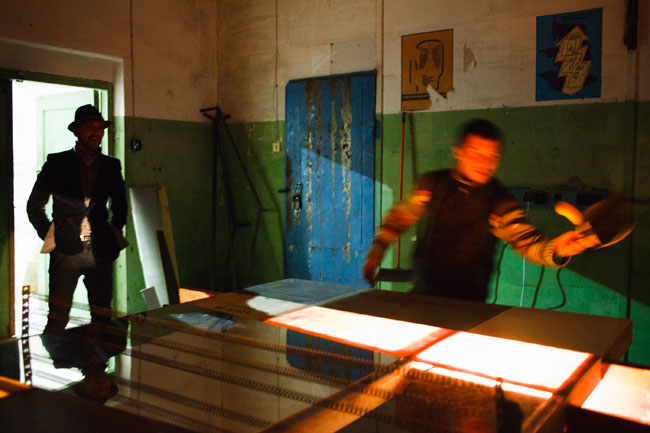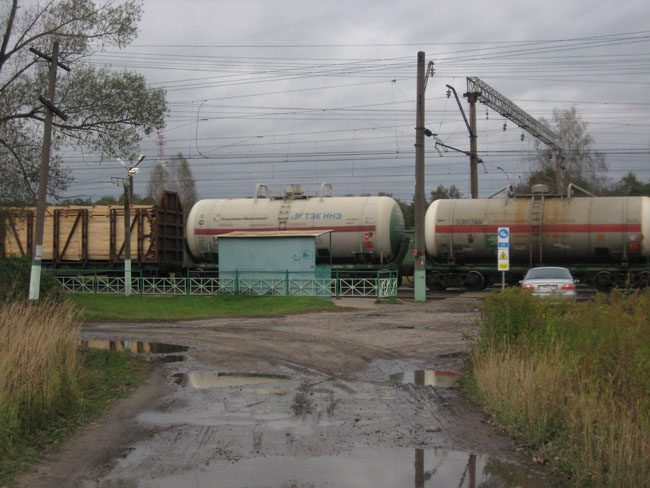|

SONICPLATTFORMING
Sonicplattforming
is an
interactive installation that uses reclaimed materials and found sounds
to create
a 'Теннисный аудиостол'
a table tennis table where sounds are triggered by bat
and ball.
Each of these three elements – object, audio and play - are
equally important, with participation vital in the activation of the
work. As in previous projects social interaction is a core aspect to the
work. We look to projects, whether temporary or permanent, which create
inviting spaces for people to meet and exchange experiences.
Site-specificity is fundamental to
Sonicplattforming. Detritus and rejected ephemera from the
surrounding area are the source of the table’s material structure,
reused and transformed to create a once more familiar object.
At Guslitsa, the finished table reflects many of the
characteristics of the building in which it was made and sited.
Industrial architectural elements were used, including doors, filing
cabinets, metal cupboards, roofing, springs and shelving, so that it
would appear that the table had grown from the same fittings and
ingredients that make up its surroundings. The table would seem very
much at home.

The audio used is a mixture of field recordings from
the environment where the installation is sited and the sounds of the
materiality of the playing surface manipulated and amplified.
The field recordings were gathered from the immediate
locale including the sounds made during the constructing of the table
itself. Once edited, these recordings were stored on a laptop to create
a library of sound specific to Guslitsa. Sounds appropriated from this
site included amongst other things building tools (drilling, screwing,
hammers and saws), musical instruments (piano, mouth harp, didgeridoo), industrial sounds
(local freight trains, plant machinery) and vocabulary (Russian and
English).
The sound files are triggered using contact mics
situated within the bats and an Arduino, an open source programmed
controller. When the ball hits the bat, a change in voltage is detected
by the Arduino which in turn then selects a sound file from within a
sound folder stored on the laptop. Power tools versus musical
instruments!
Whilst no one is playing, the table being in an idle
state generates a sound of pulsing feedback created by the bats that sit
on the table’s surface. When these are lifted to start a new game the
feedback stops. If during the game the ball hits the net, one can hear
the amplified notes created by the tensioned door springs.


As important as the aesthetic qualities, a crucial
consideration when foraging for materials was their suitability for play
and sound creation, with playability, such as ball bounce and
consistency, set against acoustic quality. In addition the workability
of the material alongside the availability of tools informed choice and
compromise.
During Plattformers’ short residence at Guslitsa other
factors influencing the decision and making process were location,
an ex-industrial building which in itself is in a state of
transformation form derelict factory to arts centre, and
communication. The cross-national, often improvised dialogue (broken
Russian and English) with the workers, the host and site manager and
other artists-in-residence played an important role in the borrowing and
exchange of tools, negotiating of suitable spaces or general
requirements such as the day-to-day needs of living in situ.

An example of this was in the logistics of where to
locate the intervention. The careful choice to use a room adjacent to the main
exhibition space was mainly lead by acoustic properties, the other
suggested spaces resulting in too much echo and disruption to the other
works exhibited. However, it was only made possible by moving the
‘workers’ temporary sleeping quarters to another part of the factory.
This required specific interaction between organisers, workers and
artists in order for the work to commence. (It was agreed that the room
would be left as found, the features of the room hinting to the
factory’s past use and activities).
These influences resulted in an installation that was
site specific, not only in its siting, rationale and aesthetic and logic
but also in the experiential. Experiences were drawn upon, fed into and
ran through the decision-making process as a whole.
Eco-Tectura Festival Guslitsa 29th September 2012
On the opening day the table attracted a lot of
different people over the day and during the whole evening who came to
play or just watch and listen.



photo by Asya
Gefter
Others came to share inspirations and ideas they had got from
experiencing the installation.
Alongside the art related audience there was a lot of children who
immediately started playing when they saw the table. Other people who
joined the experience included some of the workers who were renovating
the factory around us during the previous week and who we got to know
sharing and swapping tools and recording some of their mobile phone mp3
library to use in the table.
Special moments included the plumber who had only slept a few hours over
the last days joining us. Inspired by the field recording sounds of the
table in action he told us about his city’s monastery being famous for
Andrei Rublev’s paintings and the biggest and heaviest bell in Russia
with a height of 6m and more than 6m in diameter.
Bringing the table to its full life at the opening of Eco-Tectura
festival was a special moment that only happened through the interaction
of at least two people playing with each other. We see this moment as a
part in the process of it’s coming to life and possible being dismantled
or adapted in the future.

The site - Guslitsa Factory and
Ilyinsky Pogost
|